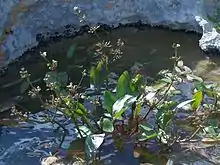Damasonium alisma
Damasonium alisma is a species of flowering marsh plant known by the common name of starfruit. Its native range includes parts of Great Britain, France, Portugal, Spain, Italy, Greece, Russia, Ukraine, Moldova, and Kazakhstan.[3][4]
| Starfruit | |
|---|---|
 | |
| Scientific classification | |
| Kingdom: | Plantae |
| Clade: | Tracheophytes |
| Clade: | Angiosperms |
| Clade: | Monocots |
| Order: | Alismatales |
| Family: | Alismataceae |
| Genus: | Damasonium |
| Species: | D. alisma |
| Binomial name | |
| Damasonium alisma | |
| Synonyms[2] | |
| |
Damasonium alisma is native to the British Isles and was at one time commonly found in south and central England.[5] Numbers have declined as a result of the loss of pond habitats.[6] It was not recorded in the wild in 2006 and is classified as endangered within the United Kingdom.[7] Seeds from the (extinct) Headley Heath population were germinated in undisturbed ponds managed by Surrey Wildlife Trust in 2013, and have grown there each year since (at least up to 2018).
Ecology
Damasonium alisma grows in acidic ponds. In Great Britain it went into decline along with the village pond. It once grew in many English counties from Sussex north to Shropshire, but by 1900 was reduced to two ponds in Buckinghamshire and one in Surrey. It is gradually starting to make a comeback due to intense conservation efforts. It requires open, well-lit, shallow water to grow in and regularly churned-up mud for its seeds to germinate.[8][9]
It is very variable in form according to the depth of the water it is growing in. Dwarf plants with aerial leaves occur growing sub-terrestrially on mud. The number of ovules vary. Usually there are two in each carpel, but carpels with four to many occur over the range. Multi-ovulate forms from southwestern Europe and Sicily were originally described as D. polyspermum.
The shape of the follicles depends on the number of seeds; the beak (empty upper part) of the carpel is elongated in two-seeded plants, whereas in many-seeded plants the seeds occupy more of the follicle and the beak is relatively shorter and less well defined.
Taxonomy
It was first described by Carl Linnaeus as Alisma damasonium in 1753, but was assigned to the genus, Damasonium, in 1768 by Philip Miller.[10][11]
References
- Lansdown, R. V. (2011). "Damasonium alisma. The IUCN Red List of Threatened Species 2011: e.T164465A5879418". Retrieved 27 June 2020.
- "Damasonium alisma Mill. | Plants of the World Online | Kew Science". Plants of the World Online. Retrieved 2020-06-27.
- "World Checklist of Selected Plant Families: Royal Botanic Gardens, Kew". apps.kew.org. Retrieved 2017-01-26.
- Altervista Flora Italiana, Mestolaccia stellata, Starfruit Damasonium alisma
- "Species: Damasonium alisma (Starfruit)", Interactive Flora of NW Europe, retrieved 11 July 2010
- Perring, Franklyn (23–30 December 1976), "Records For Leisure And Profit", New Scientist, Reed Business Information, 72 (1032), p. 725, retrieved 11 July 2010
- "Damasonium alisma", Millennium Seed Bank Project, Royal Botanic Gardens, Kew, archived from the original on 7 July 2010, retrieved 11 July 2010
- "Damasonium alisma | Online Atlas of the British and Irish Flora". www.brc.ac.uk. Retrieved 2020-06-27.
- "Damasonium alisma: Starfruit | NBN Atlas". species.nbnatlas.org. Retrieved 2020-06-27.
- "Damasonium alisma". International Plant Names Index (IPNI). Royal Botanic Gardens, Kew.
- Miller, P. (1768). Gardeners Dictionary (8 ed.). London.
External links
 Media related to Damasonium alisma at Wikimedia Commons
Media related to Damasonium alisma at Wikimedia Commons Data related to Damasonium at Wikispecies
Data related to Damasonium at Wikispecies
